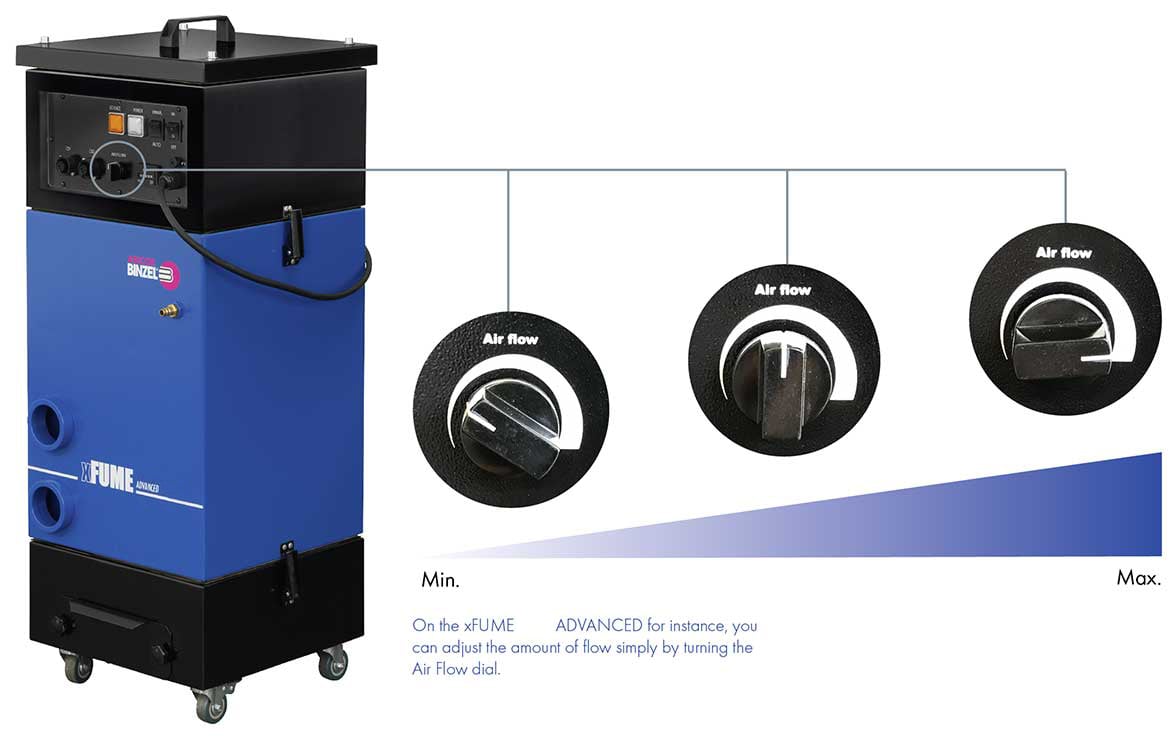Fume extraction is becoming a more necessary solution for industrial companies in the wake of continued research findings and government recommendations. Having a good grasp on what fume extraction systems are and how they work is important as you begin to consider fume extraction in your plant.
Much like a conventional household vacuum, a fume extraction system is like a vacuum you would use at home, but instead is designed specifically for weld smoke collection and filtration, and built for industrial-specific requirements.
This means these units are stronger, more powerful, and more durable than what you would associate any household vacuum with.
How Are Fume Extraction Systems Designed?
/Blog%20Photos/How%20Fume%20Extraction%20Systems%20Work/Hivac%20Cut%20Away%20Render%20Small.jpg?width=454&name=Hivac%20Cut%20Away%20Render%20Small.jpg) The inner housing of a fume extraction unit has a filter and a motor that creates negative static pressure. From a functional standpoint it is a simple system. The unit create vacuum pressure using a motor / blower like in a shop vac. A turbine within the unit spins at a rapid rate to create the power needed to collect fumes while the welder welds with the torch. These industrial-designed systems use specific blowers to get the very high static pressure you need to work with a welding torch.
The inner housing of a fume extraction unit has a filter and a motor that creates negative static pressure. From a functional standpoint it is a simple system. The unit create vacuum pressure using a motor / blower like in a shop vac. A turbine within the unit spins at a rapid rate to create the power needed to collect fumes while the welder welds with the torch. These industrial-designed systems use specific blowers to get the very high static pressure you need to work with a welding torch.
Fume extraction systems are used for all kinds of processes that create smoke in an industrial environment. You can use a fume extraction unit with a funnel or other kind of extraction kit to sit next to a non-source capturing welding or grinding application, but many are designed specifically to deal with source capture welding, where you use an accompanying fume extraction welding gun to weld and extract fumes at the same time with the same tool.
/Blog%20Photos/How%20Fume%20Extraction%20Systems%20Work/Motor-Small.jpg?width=300&name=Motor-Small.jpg)
Extraction units connect to any kind of properly fitted extraction hose kit to bring you as close as possible to the type of air pollution you are trying to capture. The most common use for a fume extraction unit is to connect to a fume extraction welding gun. But if you weld with a TIG torch, or wish to utilize smoke extraction in a robotic application, there are funnels, boot kits, or other attachments that can be used to fit to a fume extraction system in order to collect fumes at the source.
Basic fume extraction systems are made just for one welding gun, but there are some portable systems equipped for more than one torch. These will usually feature more powerful motors and bigger filters that can handle more than one fume gun at a time. If you use an extraction system, for instance, that uses four ports, make sure your equipment requirement matches the capacity of the unit so it’s still providing the right amount of static pressure for each fume extraction gun.
Fume Extraction System Power
Fume extraction units are electrically powered either on 115 or 220 V. The difference in power requirements for these units usually comes down to the power of the motor. The more power in the motor – and the unit and it’s ability to collect fumes – the higher the power requirement for the system. It’s important to know your specific welding application requirements are when looking at a fume extraction system. Factors like metal type, wire size, amperage rating, weld position, and wire feed speed will all have an impact on the static pressure and flow requirement you will have for the right fume extraction system.
Fume extraction systems come in two styles from a power perspective: high vacuum and low vacuum systems. A low vacuum system will use less power and produce less flow and may not be suited for all style of fume extraction MIG guns. These entry-level units typically will have small filters and limited features. Within the family of high vacuum portable extraction systems there many options and features. The main features are the capacity and strength of the blower to make sure it fits the application. The less powerful units are in the 1-kilowatt range, while the most powerful fume extraction systems – at least for a portable system – can get up to 8-kilowatt in power.
The vital part of any fume extraction system is the blower. The flow and pressure the blower creates will be proportional to the electrical requirements that you have.
How Fume Extraction Systems are Made
Fume extraction units and their outside casing are mainly made by metal sheet. They are made this way because you want a unit to hold up to use and abuse within the industrial environment of a plant. Most of these units will use plastic components on the hoods or the knobs of the unit, which is fairly standard although they typically prove to be durable over time.
Inside a fume extraction unit lies the blower section, the filter section, and the dust collection section. These comprise the three main parts of the unit. The blower is the part of the unit creating the static pressure, the filter section is cleaning the air that you capture and returning filtered air back into the environment, and the collect system is where the weld fume dust accumulated through the fume extraction process.
The fumes are collected by the filter. These fumes are pulled in to the filter and the particles are blocked by the membrane of the filter. Some extraction systems have a cleaning function that cleans the filter as you push the air all the around the unit as dust particles drop into the collection area.
Fume Particle Filtration and Collection
The particles that are collected into a fume extraction unit can be disposed of in two different manners. One approach is having a filter that is replaceable where the dust collects on the filter membrane itself. When the filter membrane is full by being packed with particles, you simply replace the filter with a new one.
/Blog%20Photos/How%20Fume%20Extraction%20Systems%20Work/FES-Fume-Extraction-System-Filter-Cleaning.jpg?width=370&name=FES-Fume-Extraction-System-Filter-Cleaning.jpg) Another approach is using a cleanable filter, where you collect dust into the membrane, clean it by pushing particles down to a collection bin – either with a wand (pictured) or an automatic filter cleaning mechanism with the fume extraction unit, then collect the dust at the collection bin to dispose of either through landfill waste or recycling. These types of fume extraction systems with self-cleaning filters are able to be used multiple times before needing a replacement. Often, they can last up to a year in service life.
Another approach is using a cleanable filter, where you collect dust into the membrane, clean it by pushing particles down to a collection bin – either with a wand (pictured) or an automatic filter cleaning mechanism with the fume extraction unit, then collect the dust at the collection bin to dispose of either through landfill waste or recycling. These types of fume extraction systems with self-cleaning filters are able to be used multiple times before needing a replacement. Often, they can last up to a year in service life.
Sometimes the vacuum unit does not provide equipment to clean the filter, so in order to clean the filter it must be removed and cleaned manually. When the filter is needing to be cleaned, it means all of the weld fumes particles have settled into the pleated material of the filter. If you don’t have a self-cleaning system within the fume extractor unit, these filters have to be manually cleaned, which is done by removing the filter and using compressed air to separate the fume particles from the pleat. This is not considered a safe nor effective practice. The risks and hazards of doing that include releasing more metal particles into the air and contaminating the surrounding area. If a fume extraction system promotes itself as self-cleaning but isn’t able to do so without physically removing the filter, consider your system to have disposable filters.
The other important component is the filtration of air within a fume extraction system. Some systems use a one-step filtration through a filter cartridge that you replace when full. Another have pre-filters and post-filters with HEPA – it all depends on need and the type or fumes that you will be filtering. The filter itself uses membrane filtration. You can look at the specification of your filter to make sure it filters what you are looking for. You can find filters rated for filtering chrome hexavalent particles released by welding stainless steel. The use of the right filter is critical to achieving an effective fume extraction performance and air quality level.
Optional Features of Fume Extraction Systems
Among the options that exist for fume extraction systems include:
- Automatic Start-Stop feature
- Power Adjustment
- Automatic Cleaning
- Shunt Alarms
Automatic start-stop features activate and deactivate the fume extraction system based on whether the fume extraction gun is welding or not. Within this feature, the system will activate immediately once the welding gun begins to strike an arc. When the welder stops welding, a slight delay allows the smoke to travel through to the fume extraction system before deactivating the unit – usually between 3 and 10 seconds. This feature is very useful in keeping the blower from unnecessary use and works to reduce maintenance costs in the unit while also reducing noise in the shop.
Power adjustment is the ability to control the static pressure of the fume extraction system. This is useful for adjusting the blower against the parameters of the weld machine. Reducing power can help for reducing noise and energy consumption. These features also help in the event of weld porosity or gas turbulence within the weld. These are not common occurrences with fume extraction welding with a higher performing fume extraction gun and extraction system.

Automatic cleaning allows for the filter to be self-cleaned by the fume extraction system when a certain level of dust collects onto the filter. The system is either on a timer, or it is able to detect the need for cleaning by measuring the difference in actual static pressure against the pre-set power of the unit, which then initiates a self-cleaning of the filter. The welder can continue to weld while this process takes place.
Shunt alarms are signals – either through a light or a gauge – to signal to the welder the need to replace the filter. This feature can be part of a fume extraction system with automatic cleaning or without if you were to use a system with a replaceable filter.
Noise
Portable fume extraction systems typically generate a lot of noise. The size of the motor and power of the blower will create a definite noise intensity.
The better units will use a system that dampens the level of noise created. Usually 68 to 85 dba is a commonly accepted decibel level for a portable fume extraction unit.
Ready to go deeper into fume extraction? Our eBook, The Complete Guide to Fume Extraction, is as deep and detailed a look into source capture fume extraction you will find. No form fills to read. Just click to get started.



